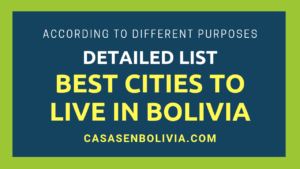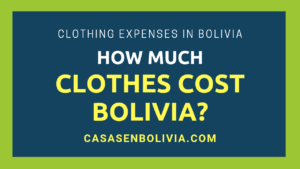Last Updated on February 14, 2025
In Bolivia, the cost of living doesn’t vary drastically between major cities. The principal cities—La Paz, Cochabamba, and Santa Cruz—exhibit a maximum price variation of around 30% for goods, services, and general living expenses. However, this difference becomes more pronounced when considering smaller towns or cities.
The two most affordable cities in Bolivia are La Paz and Oruro. Following them, with prices approximately 10% higher, are Cochabamba, Sucre, and Potosí. Santa Cruz and Tarija have prices around 20% higher. Finally, Trinidad and Cobija are the most expensive, with prices up to 30% higher. Therefore, the cost of living in Bolivia varies by approximately 30% across different cities.
We are Bolivian real estate and business experts (website) who have lived in Bolivia our entire lives. In the following sections, we’ll provide a granular breakdown of the actual differences in the cost of living and prices of goods among our country’s main cities, as well as identify the most affordable cities to live in.
Cost of Living Variations Between Bolivian Cities (Up to 30%)
While living in Bolivia, you’ll notice that all major cities have fairly similar prices for goods and services, *and the cost of living between any two major cities won’t differ by more than 30%*.
You’ll observe that cities with easy accessibility, favorable climates, and advantageous geography tend to have the lowest prices, while cities that are very remote, have extremely hot climates, or challenging geography have the highest prices.
Cost of Living in Different Bolivian Cities
Next, we’ll present the percentage differences in prices among Bolivia’s nine most important cities (the capitals of each department).
The most affordable cities in Bolivia are:
- La Paz
- Oruro
Following these, other cities have prices up to 10% higher, *resulting in a cost of living 10% more expensive*. These cities include:
- Cochabamba
- Sucre
- Potosí
Furthermore, other cities have prices averaging 20% higher than the first two cities mentioned. These cities are:
- Santa Cruz
- Tarija
Finally, other cities that are very remote and located in tropical climates with difficult access have the highest prices and cost of living in Bolivia, up to 30% higher:
- Trinidad
- Cobija
Note that Cochabamba, Sucre, and Potosí have a cost of living very similar to the Bolivian average. Therefore, La Paz and Oruro are indeed *approximately 10% cheaper (-10%) than the national average*.
| City | % Price Difference | Avg. Cost of Living (1 person) | Cost of Living – Upper-Middle-Class Bolivian (1 person) |
| La Paz | -10% | $384 | $1,341 |
| Oruro | -10% | $384 | $1,341 |
| Cochabamba | 0% | $427 | $1,490 |
| Sucre | 0% | $427 | $1,490 |
| Potosí | 0% | $427 | $1,490 |
| Santa Cruz | 10% | $469 | $1,639 |
| Tarija | 10% | $469 | $1,639 |
| Trinidad | 20% | $512 | $1,788 |
| Cobija | 20% | $512 | $1,788 |
We have a detailed guide on the actual cost of living in Bolivia, with all the specific figures and breakdowns: The cost of living in Bolivia: A complete overview.
The 3 Most Affordable Cities in Bolivia
1) La Paz
La Paz has lower prices due to its strategic location near the Peruvian border. It’s also close to rural areas that supply food to the northern part of the La Paz department. Additionally, it’s near Oruro City, which is Bolivia’s primary import gateway. La Paz also benefits from favorable geography that facilitates transportation of goods and people, and a climate that doesn’t hinder the delivery and preservation of products and services.
Although Oruro might have an even lower cost of living, we’ve ranked La Paz first *because it has a significant expat population*. La Paz is a major city, Bolivia’s second-largest urban area, with over 1 million inhabitants. In some areas, it offers a standard of living comparable to that of developed countries.
2) Oruro
Oruro City is Bolivia’s primary gateway for imports and exports. Here, you can find many products sold at significantly lower prices than elsewhere in the country. All goods arriving from the Pacific Ocean, passing through Peru and Chile, must go through Oruro before reaching other regions of Bolivia. *This is why everything is more affordable in this city*.
However, Oruro is a small city (with a population of around 300,000) *where you’ll find very few expats from developed countries*. This city is well-known for the Oruro Carnival, but beyond this festival, living there can be challenging for individuals from developed countries accustomed to higher standards of living that this city cannot provide.
3) Cochabamba
Cochabamba City is located in the central region of Bolivia and has average prices and living costs compared to the rest of the country. This is because it’s *neither too far from nor too close to Bolivia’s borders*, and it’s a large city with favorable geography and climate, which keeps transportation costs for goods moderate.
This is a large city in Bolivia and the fourth most important in the country. Several hundred foreigners from developed countries currently reside here. In some areas, there are neighborhoods with a standard of living similar to that of developed countries.
| City | % Price Difference | e.g., 1 bottle of water | e.g., 1 prepaid phone card |
| Oruro | 0% | $0.90 | $1.50 |
| La Paz | 0% | $0.90 | $1.50 |
| Cochabamba | 10% | $1 | $1.60 |
| Sucre | 10% | $1 | $1.60 |
| Potosí | 10% | $1 | $1.60 |
| Santa Cruz | 20% | $1.20 | $1.75 |
| Tarija | 20% | $1.20 | $1.75 |
| Trinidad | 30% | $1.30 | $1.90 |
| Cobija | 30% | $1.30 | $1.90 |
We have a comprehensive guide comparing the cost of living between Bolivia and the US, with detailed information on various types of expenses: Cost of Living in Bolivia vs. the US: All the Numbers and Details.
The 3 Most Expensive Cities in Bolivia
A) Cobija
This small city, located on the border between Bolivia and Brazil, is the most expensive city in our country. Prices for goods and services are, on average, 30% to 40% higher than in La Paz and Oruro.
This is because Cobija is very remote and situated in the middle of the Amazon rainforest. It has a very tropical climate and is surrounded solely by dense rainforest, lacking access to an efficient transportation system. Roads are in poor condition, and long journeys are required to transport goods and products into the city.
We advise against relocating to Cobija. You won’t find any foreigners there besides Brazilians (of whom there are many), and the standard of living is very low compared to that of a developed country.
B) Trinidad
Trinidad City is another city located in Bolivia’s tropical region, in the heart of the Amazon rainforest. It’s a relatively inaccessible city with a small population. Reaching this city requires significant transportation expenses, and the same applies to many goods and services needed there. Due to this and its climate, Trinidad has many overpriced goods and services.
We don’t recommend relocating to this city. Similar to Cobija, it doesn’t offer a good standard of living, and as you can see, it has inflated prices for goods and services, up to 30% higher.
C) Santa Cruz De La Sierra
Santa Cruz is Bolivia’s most important city. It’s also the top choice for expats from developed countries moving to Bolivia. However, this city is slightly more expensive compared to La Paz or Oruro. Prices for goods and services can be up to 20% higher than in those cities and 10% above the national average.
This city has a higher cost of living due to its location, which is far from import areas and borders. Its tropical climate, its size (with a population of nearly 2 million inhabitants), and its more complex goods and services transportation system also contribute. These factors explain why Santa Cruz has slightly elevated living costs.
Nevertheless, we encourage you to consider moving to this city if you want to live in Bolivia, as you can see in our dedicated guide about the places where foreigners actually reside in our country: Where do expats live in Bolivia? All the details and facts.
Major Bolivian Cities Are Significantly More Affordable Than Other Locations
Another phenomenon that occurs in Bolivia is that towns and rural areas have significantly higher prices for everything compared to major cities. This is because transporting goods and services to these remote locations is very difficult.
The cost of living in small Bolivian towns, and also in rural areas, can be up to 100% higher in some cases. You’ll find that food, apparel, transportation, and other essential items are sometimes even twice as expensive as in major urban areas.
But don’t worry; almost no foreigners or expats live in these places. Apart from tourism, these locations don’t meet the expectations of people from overseas for a reasonable standard of living. Therefore, almost no one from other countries, and even fewer from developed nations, choose to live in Bolivia’s small towns or rural areas, *and neither should you*.
Conclusions:
In this article about the cost of living disparities among Bolivia’s principal cities, you’ve seen that the difference isn’t substantial, only up to 30%. You’ve also learned that the most affordable cities to live in are La Paz and Oruro, with La Paz being the most affordable major city in the country.
You’ve also seen that Santa Cruz City, the primary choice for people relocating from overseas, has a cost of living 20% higher than La Paz or Oruro, and 10% above the national average. Additionally, you’ve learned that Cochabamba, another important city in Bolivia, has a cost of living that aligns with the national average.
Finally, you now know that small towns and rural areas of our country have significantly higher living costs, and prices for goods and services in these locations can be up to twice as high as in major Bolivian cities. However, almost no foreigners or expats reside in those areas.
We hope this information has been helpful. If you’d like to know more about the cost of living in Bolivia, including all the figures, breakdowns, and facts, please visit our dedicated guide here: The cost of living in Bolivia: All you need to know.
CasasenBolivia.com, information on living, working, investing, and traveling in Bolivia.








